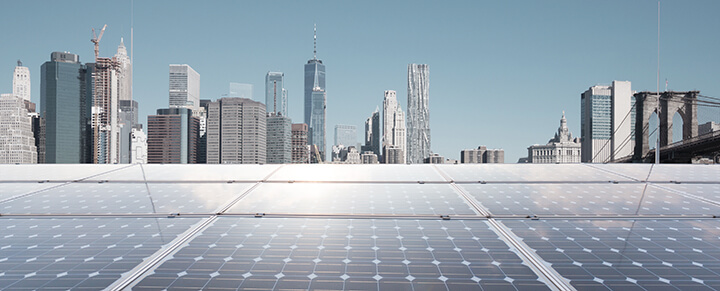
in What Does the Climate Mobilization Act Mean for New York City Building Owners?
In April of 2019, New York City Council passed the Climate Mobilization Act – a package of bills that aims to drastically reduce carbon emissions from thousands of buildings across the five boroughs through a variety of measures.
The most dramatic of those measures, Local Law 97 of 2019, which was enacted in May of 2019, establishes stringent emissions caps for buildings over 25,000 square feet. The law is the most ambitious building emissions legislation to be enacted by any city across the world and impacts over 57,000 buildings throughout the city. The goal of the law is to reduce carbon emission from buildings in the city by 40% by 2030 and 80% by 2050. Buildings will be required to comply with the emissions cap and implement energy savings measures as needed to stay within the cap, and the city has set steep fines for buildings that do not comply with the law.
City Council data shows that New York City buildings are responsible for 71% of New York City’s greenhouse gas emissions. A building’s carbon emissions are measured by totaling the carbon dioxide emitted into the atmosphere during the production of the energy that is consumed by a building. The majority of a building’s carbon footprint is energy used to heat, cool, light and power a building.
Also part of the Climate Mobilization Act, Local Law 92 of 2019 and Local Law 94 of 2019, which went into effect November of 2019, require all new buildings (as well as alterations of existing buildings where the roof deck or roof assembly is being replaced) to have sustainable roofing covering 100% of the roof. The sustainable roofing must include a solar photovoltaic system generating at least 4kW of energy, a green roof system, or a combination of the two.
Local law 95 within the Climate Mobilization Act requires a building to publicly display an energy efficiency grade. Midsize and large building owners throughout the city will be required to display an energy efficiency score and corresponding letter grade near the public entrances to their properties.
The Energy Star EPA tool will be used to generate a grade for each building based on the building type and size. The scoring system will provide an A through D grade. Any property owners who fail to submit their grade will receive a fine.
While these ambitious targets might seem difficult and expensive to achieve, the Climate Mobilization Act also included Local Law 96, which established a sustainable energy loan program for the city – Property Assessed Clean Energy – to help finance the measures required to comply with Local Law 97.
How Can C-PACE Help Meet Ambitious Climate Targets?
Commercial Property Assessed Clean Energy (C-PACE) was adopted by the city as Local Law 96 to act as a ‘carrot’ for property owners to have a source of funds available to make the necessary capital improvements to meet these strict new requirements.
Commercial Property Assessed Clean Energy (C-PACE) makes it possible for commercial property owners to obtain low-cost, long-term financing for energy efficiency and renewable energy projects. The program classifies clean energy upgrades as a public benefit and allows them to be paid for through tax assessments, the same way in which other public benefits like sewers, water lines or roads are paid. These upgrades can be financed with no money down and then repaid as a benefit assessment on the property tax bill over a term that matches the useful life of the improvements (typically aournd 20-30 years). The assessment may transfer on the sale of the property and can be passed through to tenants under certain commercial lease structures.
Measures that C-PACE can finance to reduce a property’s carbon emissions in order to prepare for compliance with Local Law 97 include but are not limited to:
- HVAC systems
- Automated building controls
- Boilers, chillers and furnaces
- High efficiency lighting
- Variable speed drives
- Building envelope
- Renewable energy
- Roof replacement
- Green roofs
C-PACE can also finance labor and associated soft costs.
While C-PACE was passed as part of the Climate Mobilization Act to help building owners meet strict emissions targets, C-PACE can also finance capital improvements to commercial and multifamily buildings whether or not they are subject to the provisions of Local Law 97. C-PACE can finance energy related capital expenditure projects in buildings of all sizes, helping property owners realize significant savings even if they are not required to comply with the emissions cap.
This past September, New York City Mayor Bill de Blasio signed an executive order to begin the process of C-PACE program development in New York City. The executive order is an exciting milestone that allows the City to begin the rulemaking process for C-PACE and will lead to a formal program launch in the near term.
To get a jumpstart on planning your building’s compliance with Local Law 97, contact Crystal Smith at Greenworks Lending to learn more!
